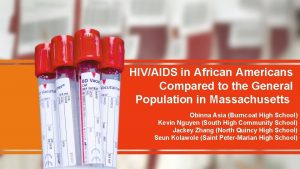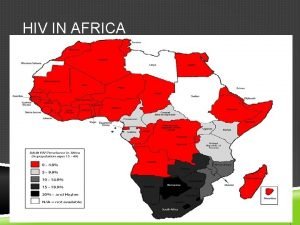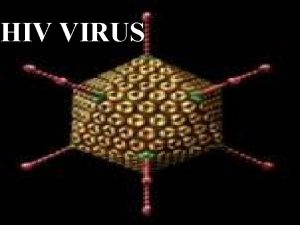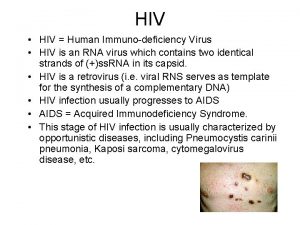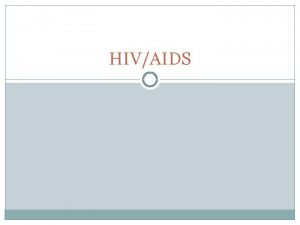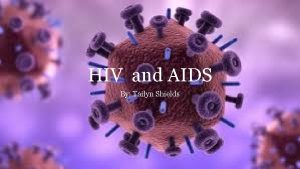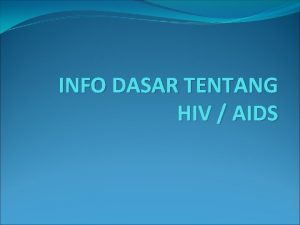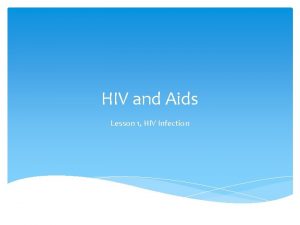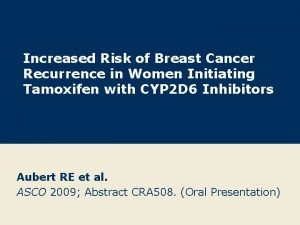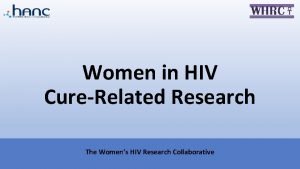Marginalized women living with HIV at increased risk














- Slides: 14

Marginalized women living with HIV at increased risk of detectable viral load: Implications for prosecutorial guidelines regarding criminalization of HIV non-disclosure in Canada and globally Andrea Krüsi 1, 2 , Kathleen Deering 1, Flo Ranville 1, Lulu Gurney 1, Melissa Braschel 1, Bridget Simpson 1, Mary Kestler 1, 3 & Kate Shannon 1, 2 on behalf of the SHAWNA Project team 1 Gender and Sexual Health Initiative, St. Paul’s Hospital, Vancouver, Canada 2 University of British Columbia, Department of Medicine, Vancouver, Canada 3 Oak Tree Clinic, BC Women's Hospital, Vancouver, Canada

Our work takes places on unceded traditional and ancestral xʷməθkwəy əm (Musqueam), Sk wx wu 7 mesh (Squamish), and Səl i lwətaʔ/Selilwitulh (Tsleil-Waututh) territories.

We would like to acknowledge the expertise and invaluable contributions of our study participants and community co-authors to the work presented today.

Criminalization of HIV non-disclosure in Canada • Using a condom or having a ‘low’ viral load is not sufficient to exclude criminal liability for not disclosing one’s HIV status to a sex partner

Criminalization of HIV non-disclosure in Canada • Department of Justice Canada Report 2017 limit application of the criminal law • Attorney General Ontario Prosecutorial Guidelines 2017 no prosecutions of people who have a sustained (for 6 months) low viral load

Objective Examine factors correlated with not having sustained viral suppression for 6 months among cis and trans women living with HIV (WLWH) in Vancouver, Canada

Sexual Health & HIV/AIDS: Women’s Longitudinal Needs Assessment Community-based longitudinal study with cis and trans women living with HIV who reside in or access services in Metro Vancouver Focused on the social, policy, legal, gender, and geographic gaps in women’s sexual health and HIV care • • COMMUNITY/ PEER-BASED • • Initiated following 6 months of community consultation on research priorities and gaps with women living with HIV and HIV care providers Participants recruited through leadership of peer research associates, HIV care providers, HIV service organizations and clinical outreach LONGITUDINAL: QUANTITATIVE & BIOLOGICAL • • Includes baseline and semi-annual questionnaires administered by peer/community interviewers and research nurses Participants receive voluntary viral load/CD 4 measurements and serology for STI/hepatitis C virus by a research nurse CLINICAL Participants are offered Pap testing and treatment onsite for symptomatic STI infections, regardless of study enrolment QUALITATIVE & PHOTOVOICE Includes a qualitative/ arts-based component with a subset of 80 to 90 participants We are committed to GIPA/MIPA principles , which ensures meaningful inclusion of the experiences of cis and trans women living with HIV in all stages of research

SHAWNA Community Advisory Boards • Positive women’s Advisory Board • Community Advisory Board

GEE Logistic Regression Analysis (2010 -2016) • Primary outcome variable: detectable HIV viral load (>=50 copies /ml HIV 1 RNA viral load) in the previous six months • Explanatory variables: time-fixed (i. e. , socio-demographics characteristics), or time-updated (to reflect occurrences within the past 6 months) • 264 WLWH on ART (947 observations over 7 years) were included in analysis • Bivariate and multivariable logistic regression using generalized estimating equations (GEE) and an exchangeable correlation structure was used to prospectively model correlates of viral suppression failure over the sevenyear period.

Descriptive Results 59% of the 264 WLWH would not meet the legal test of achieving sustained viral suppression for six months over the course of the study. Baseline characteristics of participants without viral suppression: • Median Age = 41 (IQR=33 -49) • 11% trans/gender minority • 67% Indigenous • 84% illicit drug use • 79% sex work • 26% homeless • 23% gender-based violence • 73% lifetime incarceration / 11% incarceration in previous 6 months

Results: Bivariate & Multivariable GEE Analysis Factors associated with detectable viral load among WLWH in Vancouver Canada (n=264, 947 observations), SHAWNA 2010 -2016

Conclusions & Implications • The most marginalized WLWH continue to be at increased risk of criminal prosecution

SHAWNA Project Team, Partners, & Advisories PI: Dr. Kate Shannon, GSHI Co-PI: (Quali): Dr. Andrea Krüsi, GSHI Site PI: Dr. Mary Kestler, Oak Tree Clinic • • • • Dr. Neora Pick, Oak Tree Clinic Dr. Charlotte Loppie, UVic Dr. Gina Ogilvie, BC Women’s Hospital, BCCDC Dr. Deborah Money, UBC Dr. Jeannie Shoveller, UBC Dr. Ruth Elwood Martin, UBC Dr. Putu Duff, GSHI Dr. Kathleen Deering, GSHI, UBC Flo Ranville, GSHI PRAs: Lulu Gurney, Barb Borden Sarah Moreheart, Brittney Udall, Bridget Simpson, Lauren Martin Mc. Craw, Jenn Mc. Dermid, Anita Dhanoa, Abby Rolston, Desire Tibashoboka, Maya Henriquez, Jessica Stortz, Peter Vann, Erin Seatter, GSHI Dr. Evan Wood, BCCSU Dr. Julio Montaner, BC-Cf. E Jill Chettiar, GSHI Dr. Carmen Logie, University of Toronto Positive Women’s Advisory Board Community Partner Advisory Board • • • Positive Women’s Network Sherri Pooyak, Canadian Aboriginal AIDS Network Patience Magagula, Afro-Canadian Positive Network of BC Sarah Chown, Youth. CO Jesse Brown, PAN Terry Howard, Glass. House Consultants Andrea Langlois, PAN Sandra Chu & Cécile Kazatchkine, Canadian HIV/AIDS Legal Network Dr. Sylvia Guillemi, BC-Cf. E, IDC Students/research assistants/fellows: Daniella Barreto, Meaghan Thumath, Margaret Erickson, Ofer Amran, Ariel Sernick

Acknowledgements www. gshi. cfenet. ubc. ca/SHAWNA
 Marginalized in the bible
Marginalized in the bible Market risk credit risk operational risk
Market risk credit risk operational risk Hiv risk factors
Hiv risk factors Is mold living or nonliving
Is mold living or nonliving Living non living dead
Living non living dead The smallest living unit within the human body is
The smallest living unit within the human body is Venn diagram of living and non living things
Venn diagram of living and non living things Pembiayaan risiko (risk financing)
Pembiayaan risiko (risk financing) Firm risk scorecard
Firm risk scorecard Risk projection in software engineering
Risk projection in software engineering Business risk vs financial risk capital structure
Business risk vs financial risk capital structure Inherent risks examples
Inherent risks examples The biggest risk is not taking any risks
The biggest risk is not taking any risks Risk avoidance insurance
Risk avoidance insurance Relative risk calculation
Relative risk calculation


